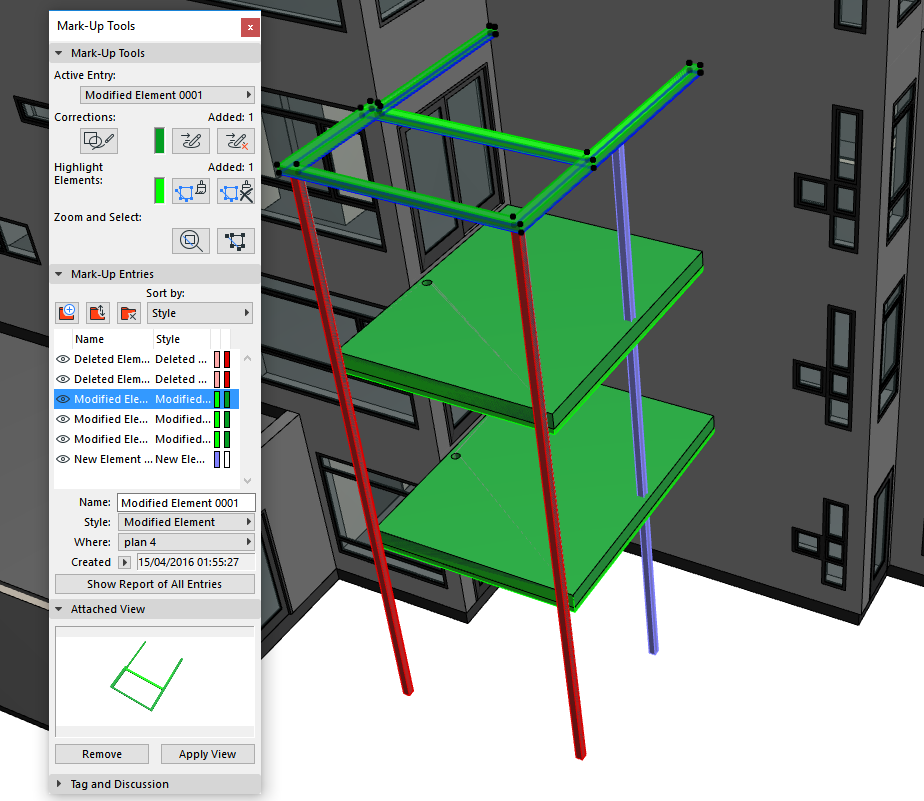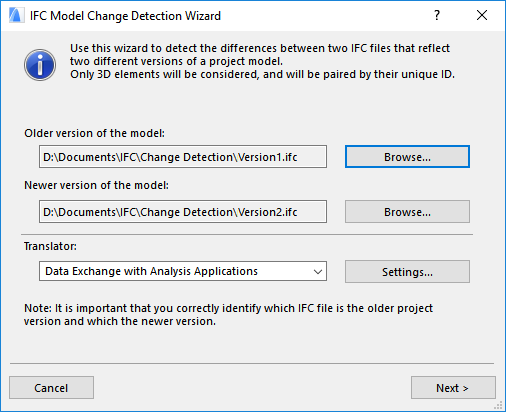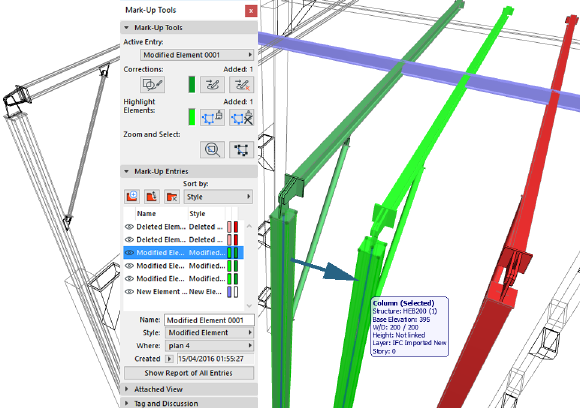
This command (File > Interoperability > IFC > Detect IFC Model Changes) detects the geometric differences between two versions (IFC files) of a single model, and merges only the modifications (new, deleted and modified elements) into the currently running project (that project can also be an empty one). Modifications can be viewed and managed using ARCHICAD’s Mark-Up tool in both 2D and 3D views.

You can restrict the change detection to only a part of the model (for example, to elements on the ground floor) or to particular element types (for example, just columns). The following geometric differences are detected:
•New Elements: elements created in the newer version that did not exist in the earlier version.
•Deleted Elements: elements that existed in the earlier version but were deleted from the newer version.
•Modified Elements: elements that have been modified (in their position and/or size) from one version to the next.
Notes
•It is important that the two IFC files being compared originate from a single application and a single project, because the comparison process is based upon the elements’ GlobalId numbers in the IFC model. If there are no identical IFC GlobalIds in the two versions, then all elements will be considered either new or deleted.
•You must correctly identify which IFC file is the older project version and which the newer version.
•The change detection applies only to 3D elements - not to any of the 2D IfcAnnotation (lines, texts, fills etc.) and IfcGridAxis elements that may be stored in the IFC file.
•Since the changes are merged into the current ARCHICAD project, we recommend that you save the ARCHICAD project before using the Detect IFC Model Changes command.
•Independently of any model exchange workflow with other applications, the Detect IFC Model Changes function can also be used to compare two versions of an ARCHICAD project: you must have saved both versions of the project as IFC files. This works if the Translator’s “Data Conversion for IFC Export” settings are set to keep the ARCHICAD IFC IDs intact.
SeeIFC Global Unique Identifier Attribute (GlobalId)
•You can use other Mark-Up functions (e.g. Comment, snapshot) to manage changes, which can be used as part of a BCF-based workflow.
See Workflows for Using BCF in Project Markup.
Follow these steps to compare two IFC files:
1.Use File > Interoperability > IFC > Detect IFC Model Changes.
2.Define a location for generated library parts.
3.In the appearing IFC Model Change Detection Wizard: Use the Browse buttons to locate and select the IFC model, noting the order in which the two files were created (“Older” and “Newer”). Keeping track of the versions is crucial to ensure the proper detection and interpretation of the changes.

4.From the pop-up list, choose an IFC Translator for Import.
Translator settings which will be applied in this process include:
•the Model Filter options for “IFC Domain” and “Structural function” (these are the default filters for comparing elements); and
•the Material and Surface Conversion settings.
Note: Layer assignment is not defined by any translator; it is defined in a later step.
Click Next.
5.Filter Elements to be Compared
Although the translator chosen in the previous step defines the default filters to be used for the elements being compared, use this page to further limit the model. In fact, you can define entirely different filters or customize them.
Use this dialog box to optionally narrow the set of elements to be compared in the two files:

•IFC Domain: Use one of the predefined domain filters to define the element types to be compared. By default, it is set to match the IFC Domain setting (in Model Filter) of the translator chosen above.
–All element types will compare all elements from the two files.
–The Structural or MEP domains will consider only IfcBuildingElements or IfcDistributionElements, respectively.
–The Custom domain filter can be created using the Options button – e.g., you can consider just beams (IfcBeam) or just columns (IfcColumn).
•Structural Function: If the IFC files to be compared include elements classified by Structural Function (that is, LoadBearing IFC Property is assigned to elements), then use this setting to filter load-bearing elements, for example as part of a structural-architectural data exchange. By default, it is set to match the Structural Function setting (in Model Filter) of the translator chosen above.
Note: Use Structural Function filtering only if you are certain that your fellow professional, with whom you are exchanging data, is using and able to export the LoadBearing IFC Property.
•Element Type: Optionally, further fine-tune the initial filtering set above (IFC Domain and Structural Function). To make filtering easier, group element types by Story, Layer, Owner, or by both Story and Layer.
Click Next.
6. Assign New/Deleted/Modified Elements to Layers
This page summarizes the detected changes, by number and type: New, Modified and Deleted elements. These changes will be merged to ARCHICAD as Mark-Up Entries.
Choose two layers onto which to place the elements. This will differentiate the elements when they are merged.

7.Merge Changes to the Project
Click “Merge” to send the changes to the project as Mark-Up Entries. The detected changes will be merged into the project and placed on the two layers you defined.
8.Vertical Position
Define the vertical position of the merged content.
See Vertical Position of Merged IFC Model (only at Merge IFC Model).
9.View changes with Mark-Up.
The Mark-Up Palette appears automatically and lists the changes as Mark-Up Entries, using three mark-up styles: “New”, “Deleted” and “Modified Elements”. Thus, the elements are easily distinguishable on screen according to their specific style. Entries can be sorted by Style and by their Floor Plan View.
Elements from the two compared models are categorized separately by the Mark-Up function:
•Elements from the older version (that is, the Deleted and Modified elements from the older version) are shown as “Correction”
•Elements from the newer version (that is, the New and Modified elements from the newer version) are shown as “Highlighted”
Each of these categories uses different Mark-Up Styles and their elements can be edited accordingly.
Functions on the Mark-Up palette enable you to view, select or zoom to the elements in the entries.
See Project Markup.
Hint: The default colors for marking different change types can be modified in the Mark-Up Styles palette (Options > Element Attributes).
Since the elements from each of the two model versions are categorized separately in Mark-Up, each Modified element entry contains a pair of elements: one element from the older model version, shown as “Correction”, and a newer-version element, shown as “Highlighted.” Their different colors make it easy to distinguish them. Moreover, each element in the pair is placed on a different layer (see Step 6 above). You can check any element’s layer by reading its Info Tag, which appears when you hover your cursor over any element.
See Element Information Pop-up (Info Tags).

Elements detected as changed become part of the project and are placed on separate layers depending on their version (older or newer). To each of these elements, the Mark-Up function assigns these elements a category: either “New”, “Deleted” or “Modified”.
Now what can you do with them?
•Deleted Element: You can leave it in as part of the project (placing it on a separate layer); or you can delete it together with its Mark-Up Entry, by clicking “Delete Entry” in the Mark-Up Palette. You can also use “Delete Entry” without deleting the elements in the Entry.
•New Element: Since it has a Highlighted status, deleting its entry will not delete the element, it will just lose its Highlighted status. Then you can use the element as you wish (or even delete it from the project). A New element will be deleted together with its Mark-Up Entry only if you first remove its Highlighted status (click the “Remove Highlight” button).
•Modified Element: This pair of elements includes one each that is “Old” and “New”, with the same options as described above for “Deleted” and “New” elements. That is, if you do a Delete Entry, the older-version element can be either retained or deleted, while the newer-version element will remain intact, while losing its Highlighted status.
Hint: If you delete a Mark-Up Entry by mistake, use Undo.